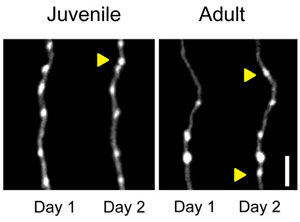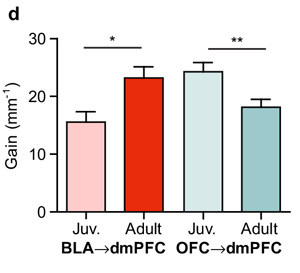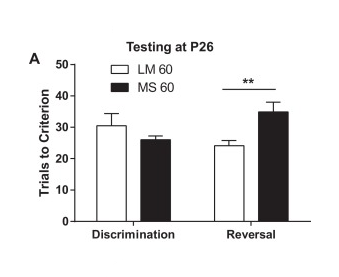
Pubmed: Wilbrecht L
Ovarian Hormones Organize the Maturation of Inhibitory Neurotransmission in the Frontal Cortex at Puberty Onset in Female Mice
The frontal cortex matures late in development, showing dramatic changes after puberty onset, yet few experiments have directly tested the role of pubertal hormones in cortical maturation. One mechanism thought to play a primary role in regulating the maturation of the neocortex is an increase in inhibitory neurotransmission, which alters the balance of excitation and inhibition. We hypothesized that pubertal hormones could regulate maturation of the frontal cortex by this mechanism. Here, we report that manipulations of gonadal hormones do significantly alter the maturation of inhibitory neurotransmission in the cingulate region of the mouse medial frontal cortex, an associative region that […]
Does puberty mark a transition in sensitive periods for plasticity in the associative neocortex?
Postnatal brain development is studded with sensitive periods during which experience dependent plasticity is enhanced. This enables rapid learning from environmental inputs and reorganization of cortical circuits that matches behavior with environmental contingencies. Significant headway has been achieved in characterizing and understanding sensitive period biology in primary sensory cortices, but relatively little is known about sensitive period biology in associative neocortex. One possible mediator is the onset of puberty, which marks the transition to adolescence, when animals shift their behavior toward gaining independence and exploring their social world. Puberty onset correlates with reduced behavioral plasticity in some domains and enhanced plasticity […]
Long-range orbitofrontal and amygdala axons show divergent patterns of maturation in the frontal cortex across adolescence
The adolescent transition from juvenile to adult is marked by anatomical and functional remodeling of brain networks. Currently, the cellular and synaptic level changes underlying the adolescent transition are only coarsely understood. Here, we use two-photon imaging to make time-lapse observations of long-range axons that innervate the frontal cortex in the living brain. We labeled cells in the orbitofrontal cortex (OFC) and basolateral amygdala (BLA) and imaged their axonal afferents to the dorsomedial prefrontal cortex (dmPFC). We also imaged the apical dendrites of dmPFC pyramidal neurons. Images were taken daily in separate cohorts of juvenile (P24–P28) and young adult mice (P64–P68), […]
Rule learning enhances structural plasticity of long range axons in frontal cortex
Rules encompass cue-action-outcome associations used to guide decisions and strategies in a specific context. Subregions of the frontal cortex including the orbitofrontal cortex (OFC) and dorsomedial prefrontal cortex (dmPFC) are implicated in rule learning, although changes in structural connectivity underlying rule learning are poorly understood. We imaged OFC axonal projections to dmPFC during training in a multiple choice foraging task and used a reinforcement learning model to quantify explore–exploit strategy use and prediction error magnitude. Here we show that rule training, but not experience of reward alone, enhances OFC bouton plasticity. Baseline bouton density and gains during training correlate with rule […]
Cell-Type-Specific Control of Brainstem Locomotor Circuits by Basal Ganglia
The basal ganglia (BG) are critical for adaptive motor control, but the circuit principles underlying their pathway-specific modulation of target regions are not well understood. Here, we dissect the mechanisms underlying BG direct and indirect pathway-mediated control of the mesencephalic locomotor region (MLR), a brainstem target of BG that is critical for locomotion. We optogenetically dissect the locomotor function of the three neurochemically distinct cell types within the MLR: glutamatergic, GABAergic, and cholinergic neurons. We find that the glutamatergic subpopulation encodes locomotor state and speed, is necessary and sufficient for locomotion, and is selectively innervated by BG. We further show activation and […]
Early maternal separation impacts cognitive flexibility at the age of first independence in mice
Early life adversity is associated with increased risk for mental and physical health problems, including substance abuse. Changes in neural development caused by early life insults could cause or complicate these conditions. Maternal separation (MS) is a model of early adversity for rodents. Clear effects of MS have been shown on behavioral flexibility in rats, but studies of effects of MS on cognition in mice have been mixed. We hypothesized that previous studies focused on adult mice may have overlooked a developmental transition point when juvenile mice exhibit greater flexibility in reversal learning. Here, using a 4-choice reversal learning task we […]
The BDNF Val68 to Met Polymorphism Increases Compulsive Alcohol Drinking In Mice Which Is Reversed By TrkB Activation
Background
The Val66 to Met polymorphism within the brain-derived neurotrophic factor (BDNF) sequence reduces activity-dependent BDNF release, and is associated with psychiatric disorders in humans. Alcoholism is one of the most prevalent psychiatric diseases. Here, we tested the hypothesis that this polymorphism increases the severity of alcohol abuse disorders.
Methods
We generated transgenic mice carrying the mouse homolog of the human Met66BDNF allele (Met68BDNF), and used alcohol-drinking paradigms in combination with viral-mediated gene delivery and pharmacology.
Results
We found that Met68BDNF mice consumed excessive amounts of alcohol and continued to drink despite negative consequences, a hallmark […]
Brief cognitive training interventions in young adulthood promote long-term resilience to drug-seeking behavior
Environmental stress and deprivation increase vulnerability to substance use disorders in humans and promote drug-seeking behavior in animal models. In contrast, experiences of mastery and stability may shape neural circuitry in ways that build resilience to future challenges. Cognitive training offers a potential intervention for reducing vulnerability in the face of environmental stress or deprivation. Here, we test the hypothesis that brief cognitive training can promote long-term resilience to one measure of drug-seeking behavior, cocaine conditioned place preference (CPP), in mice. In young adulthood, mice underwent cognitive training, received rewards while exploring a training arena (i.e. yoked control), or remained in […]
Adolescent maturation of inhibitory inputs onto cingulate cortex neurons is cell-type specific and TrkB dependent
The maturation of inhibitory circuits during adolescence may be tied to the onset of mental health disorders such as schizophrenia. Neurotrophin signaling likely plays a critical role in supporting inhibitory circuit development and is also implicated in psychiatric disease. Within the neocortex, subcircuits may mature at different times and show differential sensitivity to neurotrophin signaling. We measured miniature inhibitory and excitatory postsynaptic currents (mIPSCs and mEPSCs) in Layer 5 cell-types in the mouse anterior cingulate (Cg) across the periadolescent period. We differentiated cell-types mainly by Thy1 YFP transgene expression and also retrobead injection labeling in the contralateral Cg and ipsilateral pons. […]
Review: Between the Primate and “Reptilian” Brain: Rodent Models Demonstrate the Role of the Corticostriatal Circuits in Decision Making
Decision making can be defined as the flexible integration and transformation of information from the external world into action. Recently, the development of novel genetic tools and new behavioral paradigms has made it attractive to study behavior of all kinds in rodents. By some perspectives, rodents are not an acceptable model for the study of decision making due to their simpler behavior often attributed to their less extensive cortical development when compared to non-human primates. We argue that decision making can be approached with a common framework across species. We review insights from comparative anatomy that suggest the expansion of cortical-striatal […]





